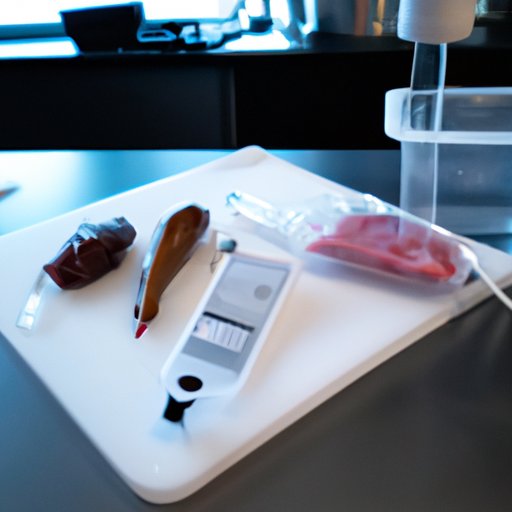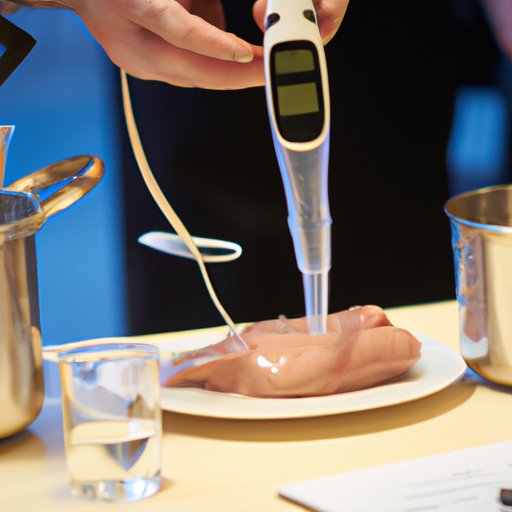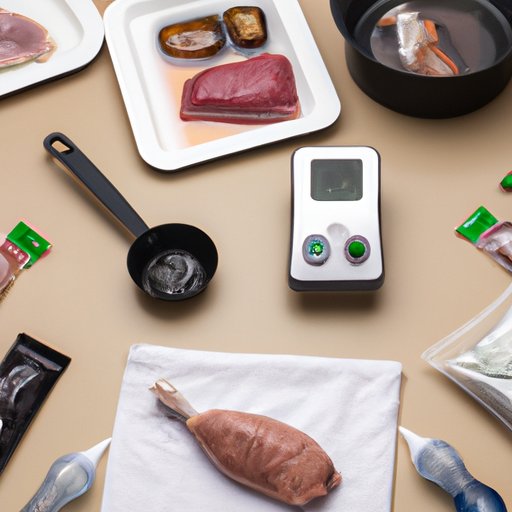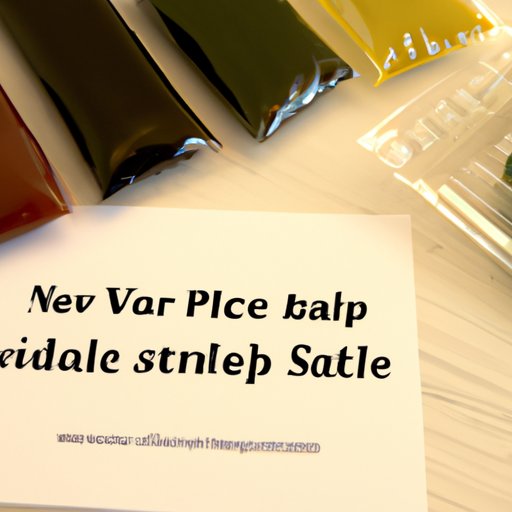Introduction
Sous vide is a type of cooking that has become increasingly popular in recent years. It involves using precise temperatures and time to cook food in a vacuum-sealed bag. This method of cooking offers a number of benefits, but it also requires careful consideration and practice to achieve perfect results. In this article, we’ll explore the science behind sous vide cooking, provide a beginner’s guide to getting started, and discuss the pros and cons of this method.

Exploring the Science Behind Sous Vide Cooking
Sous vide cooking relies on the principles of thermal conduction and convection to cook food evenly and consistently. Thermal conduction is the transfer of heat from one substance to another, while convection is the circulation of hot air or liquid around the food. By combining these two processes, sous vide can ensure that the food is cooked at a consistent temperature throughout.
Vacuum sealing is another important element of sous vide cooking. Vacuum sealing helps to keep moisture inside the bag, which prevents the food from drying out and keeps the flavors intact. It also helps to ensure that the food is cooked evenly, as the sealed bag prevents hot spots.
Temperature and timing are also key factors in sous vide cooking. Different foods require different temperatures and times to achieve the desired texture and flavor. For example, steak is best cooked at a higher temperature for a shorter amount of time, while pork should be cooked at a lower temperature for a longer period of time.
A Beginner’s Guide to Sous Vide Cooking
If you’re just getting started with sous vide cooking, there are a few basic pieces of equipment you’ll need. The most essential piece of equipment is a sous vide machine, which allows you to precisely control the temperature and time of your cooking. You’ll also need a vacuum sealer and bags, which will keep your food sealed and protected during the cooking process.
Once you have the necessary equipment, you can start preparing your ingredients. Depending on the recipe, you may need to season the food before sealing it in the bag. Once the food is prepared, you can place it in the vacuum-sealed bag and then submerge it in the water bath of your sous vide machine. Make sure to set the temperature and timer according to the instructions of your recipe.

How to Master the Art of Sous Vide Cooking
The key to mastering the art of sous vide cooking is to experiment with different temperatures and times. Choosing the right temperature is essential for achieving the desired texture and flavor. For example, if you want your steak to be medium-rare, you’ll need to set the temperature to 130°F. Timing is also important, as overcooking or undercooking food can result in an unpleasant texture or flavor.
There are several techniques you can use to achieve perfect results with sous vide cooking. One technique is to preheat the water bath before adding the food, as this will help to ensure that the food cooks evenly. You can also use a water circulator to circulate the water around the food, which will help to maintain a consistent temperature. Finally, you can use a thermometer to check the internal temperature of the food while it is cooking.

The Essentials of Sous Vide Cooking
Safety is an important consideration when it comes to sous vide cooking. When handling raw food, make sure to practice proper hygiene and food safety procedures. Additionally, it is important to ensure that the water bath is set to the correct temperature and that the food is cooked for the recommended amount of time.
It is also important to be aware of potential issues that can arise when cooking sous vide. If the water bath temperature is too low, the food may not reach the desired temperature. If the temperature is too high, the food may overcook. Additionally, if the food is not properly sealed in the bag, it may leak and contaminate the water bath.
Finally, it is important to experiment with different ingredients and techniques when cooking sous vide. Try using different herbs and spices to create complex flavors, and experiment with different cooking times and temperatures to achieve different textures. There are countless creative recipes for sous vide dishes, so don’t be afraid to get creative!
An In-Depth Look at Sous Vide Cooking
When exploring the world of sous vide cooking, there are a few things to consider. Different types of sous vide machines offer different features and capabilities, so it is important to choose one that meets your needs. Additionally, some machines are designed for specific types of food, such as fish or vegetables, so it is important to find one that is suited to your cooking style.
When creating complex flavors with sous vide cooking, it is important to understand the science behind flavor pairing. Certain ingredients pair well together, and understanding these combinations can help you to create delicious dishes. Additionally, marinating and seasoning your food before cooking can help to enhance the flavor.
Finally, there are a number of creative recipes for sous vide dishes. From steak tartare to poached pears, you can use sous vide to create a wide variety of dishes. Experimenting with different ingredients and techniques can help you to create unique dishes that are sure to impress.
Sous Vide Cooking: The Pros and Cons
Sous vide cooking offers a number of advantages. It is an efficient and reliable way to cook food, as it ensures that the food is cooked evenly and consistently. Additionally, the vacuum-sealing process helps to retain moisture and flavors, resulting in tender and flavorful dishes.
However, there are a few drawbacks to sous vide cooking. As mentioned earlier, it is important to practice proper food safety and hygiene when handling raw food. Additionally, sous vide cooking can be time consuming, as some dishes may require hours of cooking time.
Conclusion
Sous vide cooking is a popular method of cooking that relies on precise temperatures and timing to achieve perfect results. It is important to understand the science behind sous vide cooking, and to practice proper safety and hygiene when handling raw food. With the right equipment and techniques, you can master the art of sous vide cooking and create delicious dishes with complex flavors.
Whether you are a beginner or an experienced cook, sous vide cooking can offer a wide range of benefits. From efficient and reliable cooking to creative recipes, there is something for everyone to enjoy. So why not give sous vide cooking a try?
(Note: Is this article not meeting your expectations? Do you have knowledge or insights to share? Unlock new opportunities and expand your reach by joining our authors team. Click Registration to join us and share your expertise with our readers.)
